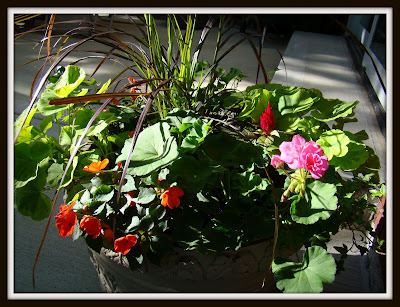There's lots to love about native plants and wildflowers, and thanks to Gail, garden bloggers celebrate them on the 4th Wednesday of each month, also known as Wildflower Wednesday.
Before celebrating our garden's wildflowers, I've got a bone to pick with Ruellia humilis, wild petunias, above.) They used to live in our back garden, and still weren't blooming after being there four years. So two years ago they were moved to full sun in front where they seem much happier. They're pretty plants, with nice, clean foliage, and sweet lavender-hued blooms. So what's not to love? Well . . . here they're the self-seeding-est plants I've ever grown! I'm not sure the ruellias will be sticking around much longer. I wanted them to bloom of course, but ended up with far more than I bargained for with their hundreds (thousands?) of seedlings. As a wise person once said, "Be careful what you ask for!"
Before celebrating our garden's wildflowers, I've got a bone to pick with Ruellia humilis, wild petunias, above.) They used to live in our back garden, and still weren't blooming after being there four years. So two years ago they were moved to full sun in front where they seem much happier. They're pretty plants, with nice, clean foliage, and sweet lavender-hued blooms. So what's not to love? Well . . . here they're the self-seeding-est plants I've ever grown! I'm not sure the ruellias will be sticking around much longer. I wanted them to bloom of course, but ended up with far more than I bargained for with their hundreds (thousands?) of seedlings. As a wise person once said, "Be careful what you ask for!"
Asclepias purpurescens - purple milkweed, on the other hand, has not been a thug. In its third year, last summer it bloomed for the first time. This year the blooms were far more impressive, but like last year they weren't pollinated. I was sorry to see the flowers fall off last week with no sign of seeds. This plant is being grown for Native Seed Gardeners, Maybe next year we'll have seeds to send.
It might be Erigeron strigosus or Erigeron annuus. Either way, it's native in Illinois, and in many other states. Common names include daisy fleabane. This was the only seedling that grew from a packet of marsh marigold seeds started last year. It baffled me more than a little since the foliage didn't look anything like a marsh marigold. It was tended in a pot all through last summer, and planted in a nice, moist spot last fall just in case.
When it started blooming earlier this month and was identified, it was tempting to pull it out. But it's grown on me. It's actually a pretty plant and it's fun watching the goldfinches all over it, eating the seeds. It makes me happy seeing them fed by our surprise wildflower. Daisy fleabane can be annual, biennial, or a short-lived perennial. I hope the goldfinches eat all the seeds, or at least that it's not a thuggish self-seeder.
Spigelia marilandica, also known as Indian Pink, bloomed early this year and is just about finished. It will usually rebloom later in the summer. After three years I've yet to find a seedling. So this year it was divided. Hummingbirds love this plant, and so do I. The red and yellow flowers are so unique and interesting.
Echinacea purpurea - coneflowers, of course, are just starting to bloom. I had a hard time growing coneflowers here at first. Cultivars would bloom for a season and never come back the following year. Finally a few years ago I bought a $3.00 packet of Echinacea purpurea seeds. They sprouted, grew, and bloomed their first year, and return every spring. Some of the fancy cultivars seem to do well in other gardens, but here the natives do best.
Coneflowers can be pretty rampant self-sowers, but here, goldfinches devour the seeds, often before the flowers have even faded. It's rare to find a coneflower seedling in our garden.
Stokesia laevis, or Stoke's Aster might be the species, or it might be a cultivar. Stokesias aren't actually native to Illinois, but they are in several southeastern states. Ours came from a garden that was getting an overhaul, saved in December as they froze in a heap of uprooted plants begging to be rescued. The Stokesias and a couple of epimediums from that garden spent their first winter here in the vegetable garden. They survived and were moved to their current homes in our shady backyard, and have been happy here ever since. Stokesia flower stems tend to get a bit floppy from the weight of the blooms, but I like them anyway. Even cultivars will self-seed, but so far there haven't had any seedlings here.
Hope you enjoyed the wildflowers blooming in our garden this hot, dry June. Please visit Gail at Clay and Limestone to see what's blooming in her garden, and follow the links to see more wildflowers blooming in gardens everywhere.


















